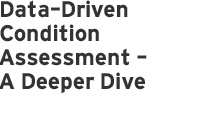 |
First steps are just being taken toward data-driven management of large scale facilities operations. Organizations are only recently moving from a spreadsheet tracking system to setting up a database. The rate of adoption and quality of asset data ties directly to decision making and the distribution of capital funds. [Component-level asset inventories based on industry standards] form a baseline data set. The next logical and necessary action is to conduct a facilities condition assessment (FCA) - a quantitative condition assessment using consistent data models.
At face value, a data-driven FCA identifies existing conditions (deficiencies, requirements) in logical groups and priorities, and associated recommended corrections and costs. A detailed FCA typically involves the architect, mechanical and electrical trades; consists of observations, life-cycle data, digital photos and CAD floor plans; and can generate reports in many forms.
Data itself possesses transformative powers – not exactly hidden but intricately woven in the details. Data helps pinpoint trends and gaps, and, when linked to business functions, creates a pathway to process improvement. That’s the ultimate goal of any asset management function including FCAs – to reduce the expense, risk and time required to benefit from the knowledge base.
|